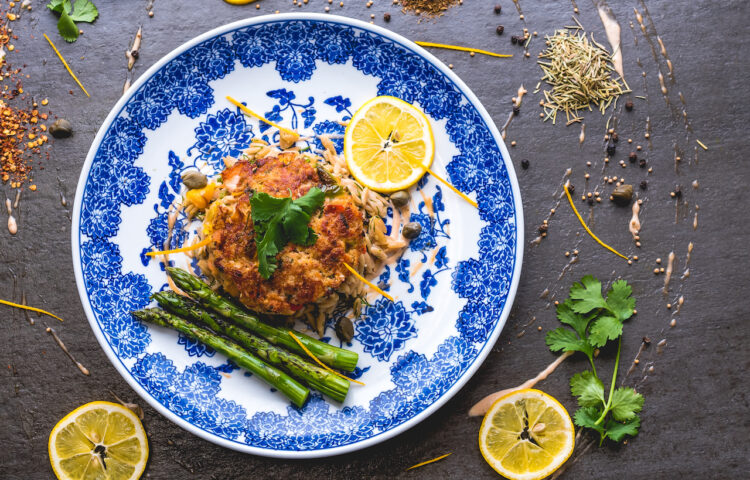The pescatarian diet is a popular dietary choice for those who want to eat a plant-based diet while still enjoying seafood. Pescatarians follow a vegetarian diet, but also include fish and other seafood in their meals.
Our pescatarian option is for those who want to exclude meat but enjoy seafood, plant-based proteins, eggs, and dairy. All of our seafood is wild caught and never from Asia or the Gulf of Mexico. Upon request, this meal plan can come in larger portions for more active individuals and those with a larger appetite or be made Paleo style for those who want to exclude grains, dairy, and processed foods from their diet.
In this blog post, we’ll dive into everything you need to know about the pescatarian diet, including its health benefits, potential drawbacks, and some delicious and healthy meal ideas.
What is a Pescatarian Diet?
A pescatarian diet is a plant-based diet that includes fish and seafood. Pescatarians follow a vegetarian diet, which means they don’t eat meat, poultry, or any animal products such as dairy, eggs, or honey. However, they do include fish and seafood in their meals as a source of protein and omega-3 fatty acids.
Why Choose a Pescatarian Diet?
There are several reasons why someone might choose a pescatarian diet. Some people choose it for ethical reasons, as they want to reduce their impact on animal welfare and the environment. Others may choose it for health reasons, as fish and seafood are high in protein, vitamins, and minerals, and may offer several health benefits.
Health Benefits of a Pescatarian Diet
A pescatarian diet can offer several health benefits, including:
Improved heart health: Fish and seafood are high in omega-3 fatty acids, which can reduce inflammation and improve heart health by lowering blood pressure, reducing the risk of heart disease, and decreasing the risk of stroke.
Weight loss: A pescatarian diet can be lower in calories and higher in fiber than a traditional Western diet, which may help with weight loss and weight management.
Reduced risk of chronic diseases: Eating a plant-based diet that includes fish and seafood can reduce the risk of chronic diseases such as type 2 diabetes, certain cancers, and autoimmune diseases.
Increased nutrient intake: Fish and seafood are excellent sources of protein, omega-3 fatty acids, vitamin D, and other essential nutrients that are important for overall health and wellness.
Potential Drawbacks of a Pescatarian Diet
While a pescatarian diet can offer several health benefits, there are some potential drawbacks to consider. These include:
Mercury exposure: Some types of fish and seafood may contain high levels of mercury, which can be harmful to health, especially for pregnant women and young children.
Limited protein sources: While fish and seafood are excellent sources of protein, a pescatarian diet may limit the variety of protein sources available, which can make it challenging to meet daily protein needs.
Limited iron sources: Iron is an essential nutrient that is primarily found in meat and poultry. While some plant-based foods are high in iron, a pescatarian diet may still limit the variety of iron sources available.
Potential for nutrient deficiencies: A pescatarian diet may also limit the variety of other essential nutrients, such as vitamin B12, calcium, and zinc. It’s important to ensure that these nutrients are still being consumed through fortified foods or supplements.
Healthy Meal Ideas for a Pescatarian Diet
If you’re interested in trying a pescatarian diet, here are some delicious and healthy meal ideas to get you started:
Salmon and Quinoa Bowl
Ingredients:
4 oz salmon filet
1/2 cup cooked quinoa
1/2 cup roasted vegetables (such as sweet potato, bell peppers, and zucchini)
1/4 avocado
1 tbsp olive oil
1 tbsp balsamic vinegar
Salt and pepper to taste
Instructions:
Preheat the oven to 400 degrees F.
2. Place the salmon filet on a baking sheet and season with salt and pepper.
Roast the vegetables with 1 tbsp olive oil for 15-20 minutes until tender and slightly browned.
In a separate bowl, combine the cooked quinoa, roasted vegetables, and sliced avocado.
Drizzle the balsamic vinegar over the quinoa bowl.
Serve the salmon fillet on top of the quinoa bowl.
Shrimp and Vegetable Stir Fry
Ingredients:
1 lb shrimp, peeled and deveined
2 cups mixed vegetables (such as broccoli, carrots, and bell peppers)
1 tbsp olive oil
1 tbsp soy sauce
1 tbsp honey
1 clove garlic, minced
Salt and pepper to taste
Instructions:
In a small bowl, whisk together the soy sauce, honey, and minced garlic.
Heat a large skillet over medium-high heat and add 1 tbsp of olive oil.
Add the shrimp and stir-fry for 2-3 minutes or until pink.
Remove the shrimp from the skillet and set aside.
Add the mixed vegetables to the skillet and stir-fry for 3-4 minutes or until tender.
Return the shrimp to the skillet and add the soy sauce mixture.
Stir-fry for an additional 1-2 minutes until everything is coated in the sauce.
Serve over rice or quinoa.
Tuna Salad Lettuce Wraps
Ingredients:
2 cans of tuna, drained
1/4 cup diced celery
1/4 cup diced red onion
1/4 cup diced bell pepper
1/4 cup plain Greek yogurt
1 tbsp Dijon mustard
Salt and pepper to taste
Lettuce leaves for wrapping
Instructions:
In a mixing bowl, combine the drained tuna, diced celery, red onion, and bell pepper.
In a separate bowl, whisk together the Greek yogurt, Dijon mustard, salt, and pepper.
Pour the yogurt mixture over the tuna mixture and stir until well combined.
Serve the tuna salad in lettuce leaves for wrapping.
In conclusion, the pescatarian diet is a plant-based diet that includes fish and seafood. It can offer several health benefits, including improved heart health, weight loss, and reduced risk of chronic diseases. However, it’s important to be aware of the potential drawbacks, such as mercury exposure and limited protein and iron sources. With these delicious and healthy meal ideas, you’ll be well on your way to enjoying the benefits of a pescatarian diet.

